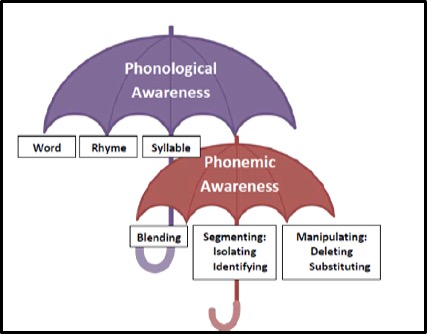Research tells us that literacy instruction must be both explicit and integrated. Children learn phonological and phonemic awareness in overlapping stages and teachers should target multiple goals simultaneously (Skibbe, Gerde, Wright, & Samples-Steele, 2016). This means that you will be teaching children a new letter sound or symbol during a whole group lesson, while at the writing center or in small groups children are associating sounds and symbols they have already been introduced to.
What is the difference between Phonological & Phonemic Awareness and Phonics?

Phonological and Phonemic Awareness is the understanding that spoken language can be broken down into smaller sound units. For example: sounds make words, and words make sentences that we speak and hear. Each word is made up of individual sounds called phonemes. Phonological awareness sets the stage for students to eventually correlate sounds and symbols; a skill needed for reading and writing. A child’s ability to read and write is shaped by their understanding of the sounds that make up words.
When we begin to map sounds onto symbols (letters) that we print and manipulate through printed, visual representations, we move into the area of Phonics and letter-sound correspondence.

A good way to remember the distinction is that Phonological and Phonemic awareness happens “in the dark” – in the absence of printed letters. Children’s early exposure to sounds all happens without needing written letters or words to teach phonological skills. Babies play with sounds when they babble – no letter symbols needed – as they engage in the process of noticing, thinking about, and experimenting with sounds in spoken words.
In PreK we tap into children’s natural interest in sounds and patterns and intentionally introduce the skill of focusing on and discerning distinct language sounds using simple games such as the I-Spy game: “I spy with my little eye something that hops and starts with “f,f,f,f”. These activities help children become even more aware of the sounds of language as they play with rhyme, alliteration (See Sally swim slowly), syllables and sound sorting (which of these objects begins with ‘m,m,m’?).
The progression while not entirely linear is:
- Active listening.
- Gradually introduce children to the symbols or letters.
- Support the association of sounds and symbols.
- Making marks that represent the words.
- Connecting with relevant vocabulary.
- Beginning to write using invented spelling.